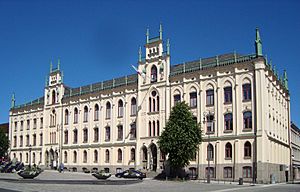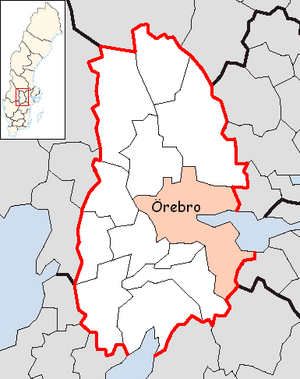Örebro Municipality facts for kids
Quick facts for kids
Örebro Municipality
Örebro kommun
|
||
|---|---|---|

Örebro Town Hall
|
||
|
||
 |
||
| Country | Sweden | |
| County | Örebro County | |
| Seat | Örebro | |
| Area | ||
| • Total | 1,628.83 km2 (628.89 sq mi) | |
| • Land | 1,380.15 km2 (532.88 sq mi) | |
| • Water | 248.68 km2 (96.02 sq mi) | |
| Area as of January 1, 2010. | ||
| Population
(June 30, 2012)
|
||
| • Total | 134,725 | |
| • Density | 82.7127/km2 (214.2250/sq mi) | |
| Time zone | UTC+1 (CET) | |
| • Summer (DST) | UTC+2 (CEST) | |
| ISO 3166 code | SE | |
| Province | Närke and Västmanland | |
| Municipal code | 1880 | |
| Website | www.orebro.se | |
Örebro Municipality (which in Swedish is Örebro kommun) is a special type of local government area called a municipality. It is located in Örebro County in central Sweden. The main town and administrative center of the municipality is the city of Örebro.
This municipality was formed in 1971. It brought together the City of Örebro and the smaller towns around it. In 1974, some more areas were added, making it 1,840 square kilometers big. Later, in 1995, a part of Örebro Municipality became its own separate area again, called Lekeberg Municipality.
Towns and Villages
Here are the main towns and localities in Örebro Municipality that have more than 800 people living in them:
- Örebro (This is the largest city and the main center of the municipality, with 126,604 people)
- Hovsta (2,700 people)
- Odensbacken (1,400 people)
- Vintrosa (1,300 people)
- Mosås (900 people)
- Stora Mellösa (800 people)
Other smaller places include:
- Latorp (500 people)
Population Changes
The number of people living in Örebro Municipality has grown a lot over the years. In 1970, there were about 117,696 people. By 2020, this number had increased to 156,381. This shows that more and more people are choosing to live in this area.
| Year | Population | ||||||||
|---|---|---|---|---|---|---|---|---|---|
| 1970 |
117,696
|
||||||||
| 1975 |
117,837
|
||||||||
| 1980 |
116,969
|
||||||||
| 1985 |
118,043
|
||||||||
| 1990 |
120,944
|
||||||||
| 1995 |
119,635
|
||||||||
| 2000 |
124,207
|
||||||||
| 2005 |
127,733
|
||||||||
| 2010 |
135,460
|
||||||||
| 2015 |
144,200
|
||||||||
| 2020 |
156,381
|
||||||||
|
Source: SCB - Folkmängd efter region och år. |
|||||||||
How People Vote
In Örebro Municipality, just like in other parts of Sweden, people vote in elections to choose their leaders. These leaders then make decisions about how the municipality is run. Different political parties have different ideas about how things should be done. People vote for the party and the politicians they think will do the best job.
Sister Cities
Örebro Municipality has seven "sister cities" around the world. These are cities that have a special friendship and partnership with Örebro. They often share ideas and learn from each other. Here are Örebro's sister cities and when their friendship started:
- (1946) Kolding Municipality, Denmark

- (1946) Drammen, Norway

- (1947) Lappeenranta (Villmanstrand), Finland

- (1979) Stykkishólmur, Iceland

- (2001) Łódź, Poland

- (2002) Yantai, China

- (2003) Terrassa, Spain

See also
 In Spanish: Municipio de Örebro para niños
In Spanish: Municipio de Örebro para niños


